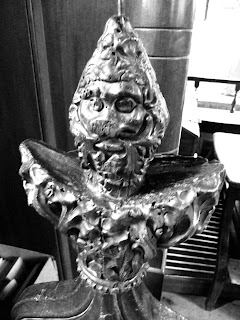Woolpit, Suffolk or Wolfpit (Ulfcytel)
The small rural bus journeyed me across central Suffolk, inducing travel-sickness as it veered the bends of the country roads and its villages. I had come to see the architecturally celebrated church of St Marys, Woolpit. The village named not after the riches of the mediaeval wool-country but earlier, from the Anglo-Saxon Wolf-pits. Immediately from exiting the bus, we are within the charm of the triangular villlage green; itself a survival of the Saxons - used for penning-in the livestock.., from the wolves and such like. The village has all the right components: Post-office selling faded/aged postcards and itself carrying an advertising hoarding from the early 20th century 'Telegrams sent from here!'. There is also the village pub: http://www.woolpitswan.co.uk/homepage.htm, an unpretentious bake-house, a lovely cafe (that kindly warmed my wendling self with a generous cafetiere for one), above the aforementioned cafe - the village museum; set within a listed timbered building and open for a few token hours a week. Immediately within the village green triangle, is the Church of St Mary.
St Marys, Woolpit. The south porch (15th c), like a stone reliquery.
As we approach the church, we see the astonishing porch for which Woolpit (along with its fine double-hammerbeam roof) is reknown. I stand and marvel for almost ten minutes; I am being watched by a couple tending a grave. I always appear suspicious and almost convince myself I am here to 'rob the silver & remove the roof lead'. Its okay though, I remove my camera from the satchel and this veils the threat I must hold to the grave-tenders. Inside the porch door, a lierne roof vault; 'rare in East Anglia' (Jenkins 2000) and, above that a first-storied room that likely held parish records or venued meetings. The small ancient door steps down into the South aisle.
The double hammerbeam roof & English Gothic Nave of St Marys, Woolpit.
St Marys. Woolpit. Green men disguised within the choirs poppy-headed finnials.
St Marys, Woolpit. Another Green man.
St Marys, Woolpit. Artifact of a Wode-man.
I discover (as the above photographs illustrate) Green men, disguised within the foliate of the bench ends. Also, near the Chancel a carved Wode-man of the forest. All intriguing, given that Woolpit is associated with the tale of 'the green children'. The story hails from the reign of King Stephen (1135 - 1154) and tells us that a young boy & girl were found by the Wolf-pits, they were green-skinned, dressed in strange clothes & spoke a foreign tongue. The boy was to die, yet the girl was to live, lose her green appearance and marry; going on to live in Kings Lynn. The tale reeks heavily of the aural-folk tales of Anglo-Saxons & the Vikings. It also has parables to Gawain & the Green Knight, Robin Hood & the Babes in the Wood.
St Marys, Woolpit. Chancel screen. An original rood beam exits above.
St Marys, Woolpit. Screen paint detail. The colours of the middle-ages mingles with Victorian.
St Marys, Woolpit. The pews are near all 1400s, all with animal/bestiary carvings.
I sit and absorb the building; the rain pattering away outside. I read the church guide and go in search of the buildings treasures. The only disapointment here is the window glass. The Ailses are narrow which Betjeman ( 1958) deem were for processional use only. I eventually take my leave, ducking out of the short aged door. I examine the porch interior in more detail. It really is akin to a stone reliquery, like an exterior chantry. The lierne vault is littered with animal faces. As I exit, two gentlemen & a lady approach; themselves armed with a county church arcitecture guide. "Look, somebody else doing what we do Robin!"; proclaims the outwardly more eccentric of the men.., the lady appeared more 'taken out on a rainy-day trip', and less enthusiastic. They talk briefly of all the locked churches they have encountered. I bid them good-day and, make way to the village.
St Marys, Woolpit. The South Porch.
St Marys, Woolpit. Clerestory flush-work & the poorer North side construction; the North side of English Parish Church buildings often suffer so, much like the poor - also traditionally buried in the dismal North aspect of graveyards.
Woolpit, Suffolk.
I find the Bake-house and take the last two homemade cheese-scones & a ginger-cake, wrapped in paper - stuff them into my canvas satchel & then off into the warm of the tea-room below the museum (the orange timbered building). I am served hot coffee and a baked potato before heading back to the post office for the village-shuttle bus service, back to Bury St Edmunds. I plan to return on a warmer day than this and explore the Spring/Lady Well.
Woolpit, Suffolk.
Woolpit is found on Ordnance Survey, Explorer series sheet 211: Grid Reference: TL973624.
The well can be found: http://www.megalithic.co.uk/article.php?sid=8322


























